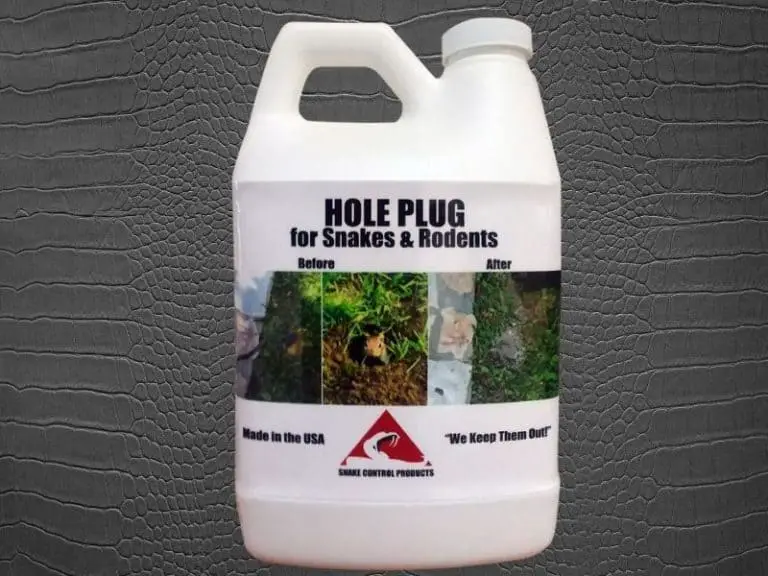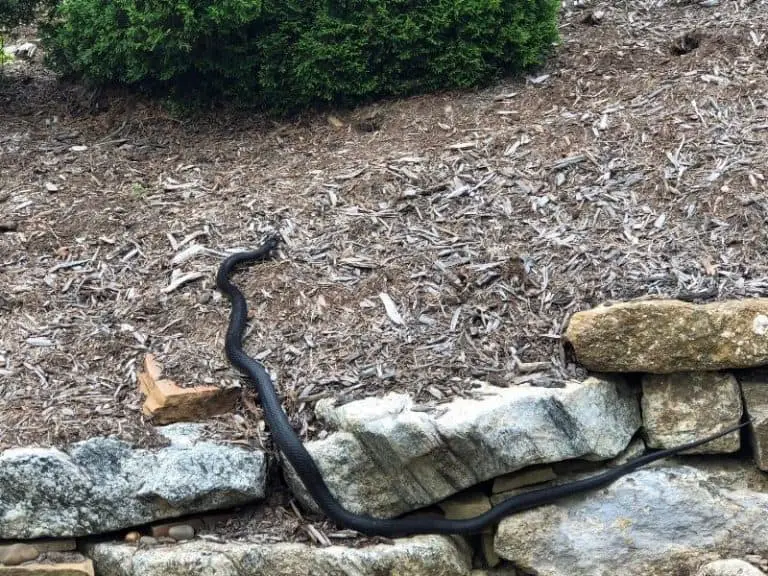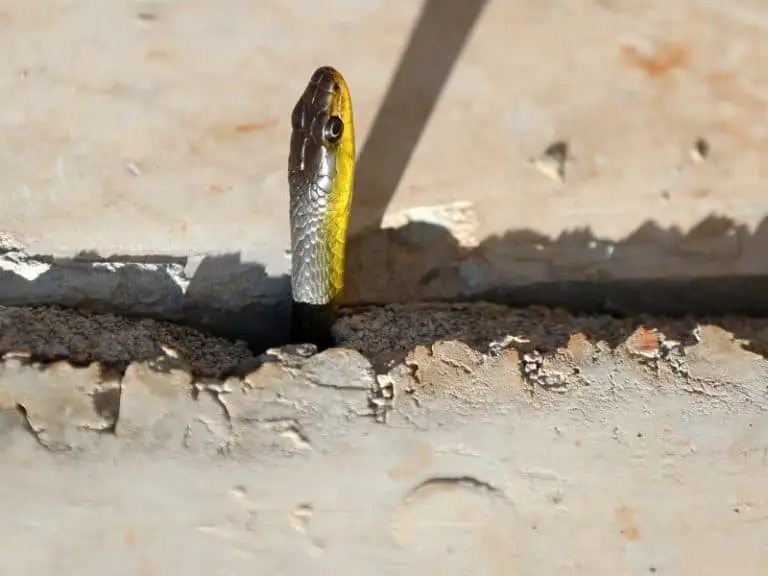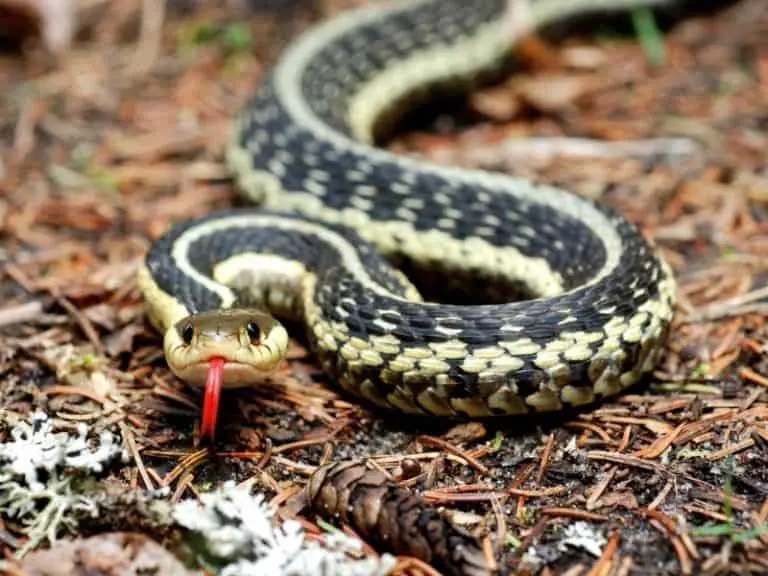How to Snake Proof Your Garage
Many homeowners are having a problem regarding how to keep their garage snake proof. They report that it is a constant and uphill battle and that they are finding it hard to win the fight.
Snakes are naturally attracted to a garage because it is cool, dark, and seemingly safe as a shelter, shade, and hiding place. It protects snakes from the weather, the heat, and from predators, and it can also harbor mice and rats which are among their favorite food.
It is fortunate that there are several measures to keep them out. We offer some tips on how to snake-proof your garage.
Snake proof your garage by sealing and repairing holes and entrances on walls and under your garage door. Remove debris and hiding places and keep the floor clean. Trim plants around the garage. Eliminate rodent and insect pests that snakes eat. Apply sulfur and mothballs regularly as repellents.
To prevent your garage from being a safe and attractive shelter for snakes, prevent all possible entry points and eliminate snake food sources and places of shelter.
We will teach you in detail the various measures you can employ to help prevent the occurrence of snakes in and around your property and garage so that you need never worry about snakes anymore.
How To Snake Proof Your Garage
There are many steps you can take to snake-proof your garage, as well as help, prevent them from returning or being attracted to it. we enumerate the different steps and discuss them below.
Seal and repair all holes
Garages can have small holes on the wall. In addition, the underpart of the garage door could have openings when the weather seal has been worn out. This is especially true for older garages.
You may want to check if the weather seal of your garage door already has weak spots and is already accessible to snakes. It is also advisable to fill all the holes that are present on your walls.
You may contact suppliers and installers to repair or replace your garage door weather seal and repair or replace your garage door.
Keep in mind that there are snakes that can enter your garage through openings that are as small as the width of a pencil.
For sealing holes, gaps, and cracks on your wall, you may use caulking and expansion foam sealants. Gaps where the plumbing and wiring enter can be applied with these materials. You can use hardware cloth for large points of access.
The same goes with your entire home. There can be many entry points that snakes can use to get into your house. You can easily overlook your pets’ doors as snakes’ entry points.
Remove all debris
Make sure you regularly remove all debris in your garage.
Many people commonly use their garages as a DIY work area for various kinds of projects. There are usually a lot of debris from such projects, and these are ideal hiding places for snakes.
It is a common trait of snakes to want stay in hiding instead of being openly exposed. They are especially shy of people, who, from their perspective, are frightening giants.
Thus, a debris pile is perfect for hiding and even nesting for these animals.
You can discourage them from making your garage their home by ensuring that all debris is properly eliminated every time you produce them and after every session of DIY project making and other similar activities.
Make it a habit also to maintain a clean and clear floorspace.
Eliminate clutter where snakes tend to hide
Now, this may not be completely practical.
Garages are common places where people stock many of the things they don’t want cluttering their homes. It is also the place for tools for the home and for vehicles.
While it may not be possible to remove all things in the garage, if you keep them well arranged so that there is little to no space behind them that are dark and out of your sight, then you can effectively prevent snakes from using them as hiding places.
This is an essential and excellent way of keeping your garage snake proof when coupled with the other tips we discuss.
Trim all vegetation surrounding the garage
When the vegetation, including all plants and trees, are allowed to grow excessively in your property, especially those surrounding your garage, they can be welcome places where snakes can hide.
Overgrown vegetation around and near your garage is only a step away for snakes to invade your garage.
Snakes are uncomfortable crossing and lingering in open areas, and often stay concealed as often as they can.
Wherever they come from, if they can seek refuge in the plants near and around your garage, it becomes easier for them to take their time exploring, looking for, and finally using the openings in your garage to gain entry.
Another negative consequence of overgrown plants around your garage is the contribution they make in damaging your garage door and walls.
If these plants are well trimmed or eliminated, the snakes are left with no hiding area for them to more easily cross the divide from their natural habitat to your garage.
Without these plants, snakes are less likely to stay around your garage and eventually enter it.
Related Post: 5 Snake Attracting and 22 Snake Repelling Plants
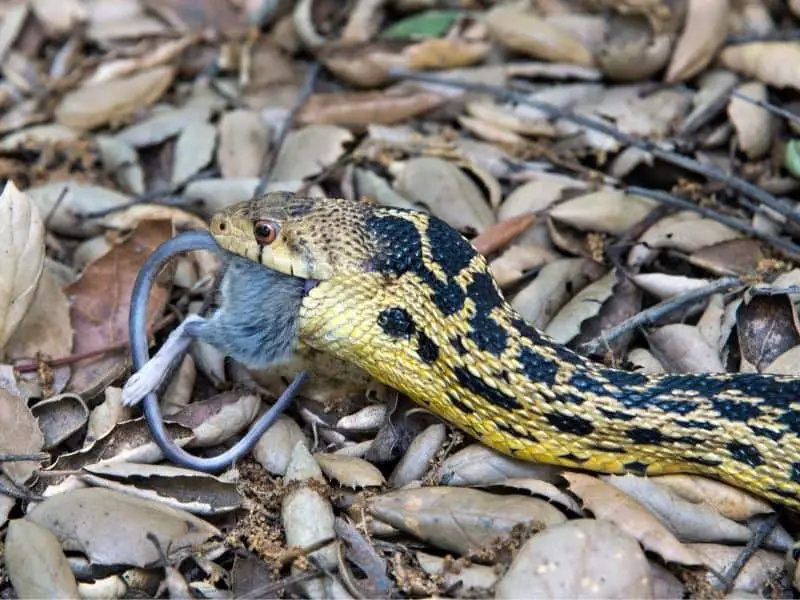
Eliminate food sources for snakes
All snakes are carnivorous, and many snakes have mice and rats as part of their usual food. Unfortunately, these rodents are common pests in the home.
With these unwanted invaders in our garage, snakes have even more reason to colonize your garage.
Aside from the shelter and shade, your garage provides, having rats and mice will also give snakes an excellent food source.
This will encourage them to stay in your garage even more because they have less reason to go out and hunt. Their food supply is conveniently within their reach.
You can use rodent traps or poison bait to eliminate them. Alternately, you can also hire pest exterminators for expert rodent eradication and removal.
Remember that when you use poison to eliminate rats, it can also harm your pets, children, and other wildlife if it is not used properly or not applied according to manufacturer’s instructions.
Eliminate attractants of snake prey
You should also remove all the elements that attract rodents to your garage and home.
Sealing holes and removing clutter, as well as making sure pet foods are inaccessible to rodents, go a long way in preventing rodent infestation.
It is also worth noting that rodent pests make additional holes in your garage and home that can serve as additional entry points for snakes.
Related Post: Mouse Proof Garage Storage: Best Containers to Keep Mice Out
Keep your garage unpleasant for snakes
Snakes are equipped with a keen sense of tasting and smelling.
They have these senses combined in their Jacobson’s organ. They have forked tongues that they can flick in the air to “taste” it.
The tongue collects chemical particles in the air that are deposited into the Jacobson’s organ at the roof of their mouths when they retract the tongue.
The Jacobson’s organ then relays the information to the brain, so that the snakes identify what it detected.
This combined smelling and tasting organ and sense are very sensitive and sharp. They help snakes locate their prey, detect potential predators, and assess the condition of their general surroundings.
If you make your garage unpleasantly smelling to snakes, they will get discouraged in using your garage as their home.
You can make your garage unpleasant to snakes by repelling them with sulfur and mothballs.
The scent emitted by these materials is agitating to snakes and will encourage them to leave your garage.
You may place some mothballs or sulfur on the hidden parts of your garage where snakes are most likely to hide.
Install fences
Installing fences in strategic areas can be useful in deterring snakes and preventing them from colonizing your garage.
Edges of woods and along the margins of wetlands and lakes are possible areas where you can install snake fences.
Remember, however, that fencing an entire property or yard is costly and takes a lot of time. It may be considered as a last resort because it is not too practical.

6 Reasons Why Snakes Love Your Garage
Now let us discuss in more detail why snakes, if they are shy and are generally afraid of humans who are gigantic (relative to them), still tend to enter people’s homes including their garages.
What is in the garage that snakes get attracted to?
Why don’t they just stay in the woods or in places that comprise their natural habitat?
Why do they want to go inside your garage?
Snakes are usually unwanted by most people. Fear is the most common reaction to snakes, and people who love snakes or are not afraid of them are still in the minority.
Even though our awareness, love, and conservation of wildlife have vastly improved within the last few decades, we sometimes still exclude snakes from our consciousness.
Many people simply want snakes dead, or at least far away from them. They abhor any encounter with them.
This may be due to the fact that people have been conditioned, intentionally or not, to be repulsed by snakes and even fear them.
A lot of the fear has to do with the mortal danger posed by venomous snakes. However, there is also much unreasonable fear.
Most snake species are actually harmless.
Out of all the snake species in the world, only 7 percent are actually dangerous to humans.
And yet, the stigma carried by snakes is usually borne both by venomous and non-venomous species alike.
The thought of coming face to face with a snake in any situation is a terrifying prospect for many. Unfortunately, snakes can still enter your garage regardless of your feelings about them.
Understanding the reason why animals like snakes enter garages is the key to keeping them out. If you understand their motives, you can use this knowledge to demotivate them and discourage them.
In addition, killing snakes should not be an option, because they are an important part of the ecosystem and environment, and animal welfare should be taken into consideration.
They are creatures who deserve compassion and kindness, too, even if most people do not find them cuddly or cute.
After all, snakes have and never will have any ill intentions towards man. Except for some gigantic pythons in other continents, snakes never consider man as food.
On the contrary, snakes are deathly afraid of us. They would rather avoid us because we can easily kill them.
Let us discuss the varied reasons that snakes have in entering our garages. These reasons are many.
However, just because garages can be inviting to a snake does not mean you will always find one inside yours. The key is to make your garage as inhospitable and as less inviting as possible to them.
Snakes Seek Shelter in Garages
Snakes find garages attractive as ideal shelters, especially those that are surrounded by long grass, yard litter, and dense shrubbery. When they finally make it inside your garage, they prefer to stay in corners, along the walls, and behind and under clutter and other stuff.
If your garage has lots of clutter such as debris, lumber, and debris, snakes will perceive them as welcoming and attractive habitats.
Garages Can Be a Place for Brumation
Snakes are not hibernating animals, but they undergo something similar called brumation.
As the weather becomes colder, they look for places that have enough shelter where they can curl up and sleep the winter through.
During this time, they are still able to become active, drink water, or bask under the sun if the day is relatively warm.
Garages Provide Source of Heat
Snakes are ectothermic animals. They depend on the ambient temperature to maintain their needed body temperature.
Cool weather at any season may cause them to search for places that have enough heat. These could include your hot water heater as well as warm spots under appliances near their hot motor.
They Provide Area for Cooling Down
Conversely, snakes need to cool down when the weather is very hot. And so, they could seek out your garage, since it can offer a cool and dark place where they can rest. Damp concrete can be an easy means of cooling down for snakes during the intense summer heat.
Garages are Usually Quiet
If a snake’s natural habitat is disturbed, for example when area clearing or a construction project is conducted in the place where it lives, it will naturally have the tendency to relocate.
The disturbance could eventually drive the snake to the relative quiet and safety of your dark garage.
They can also be forced to relocate if their food source has been disrupted by such occurrences. If you start noticing an increase in the sightings of rodents, frogs, and other prey animals of snakes, then the snakes may eventually follow and show up in your area.
Rodents Serve as Source of Food for Snakes
If your garage provides a delectable menu of prey items for snakes to feed on, then it is only natural for hungry snakes to seek out these rodents and enter your garage.
Keeping items in your garages such as potting soil, bird seed, trash, cooking grill, pet food, and anything else which provides shelter and food for rodents will attract these small mammals. Their snake predators may then in turn be attracted by them.
Such items as unsecured pet food will also attract opportunistic insects such as cockroaches, which are also yummy food items for many snakes.
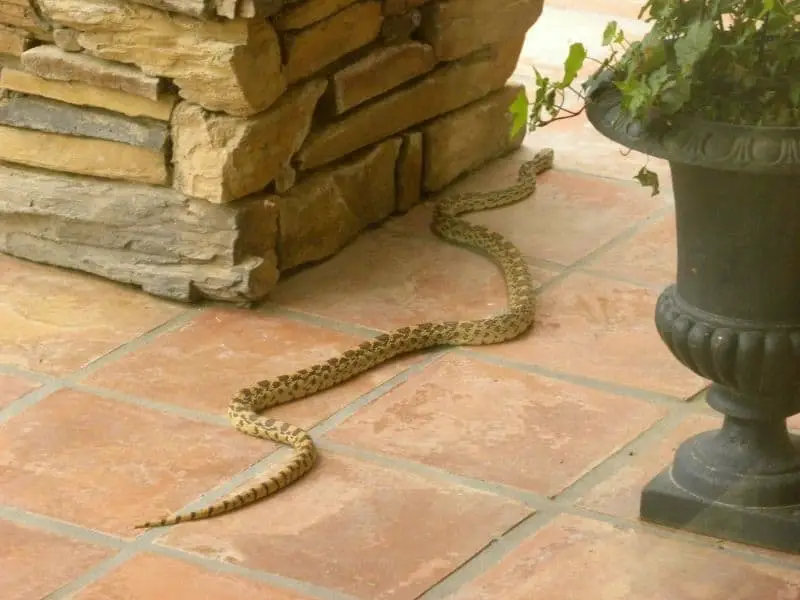
How Snakes Get Into Your Garage
Snakes can get in almost anywhere if there is enough motivation for them to do so. As for your garage, there are various entry points that they can use to their advantage.
An open garage door is the easiest way they could get through undetected if you are not looking. With a closed garage door, they still have the options of entering your garage through small cracks, holes, and crevices.
An outer trim that does not reach all the way down to the concrete floor is an easy entry point for most snakes.
It is also important to remember that despite being limbless and legless, snakes are agile climbers capable of climbing many structures that even humans and limbed animals may have trouble climbing. Snakes can easily get to high and relatively inaccessible openings.
These can include pipes, unsecured and open windows, cracks on your wall, vents, loose roof tiles, ceilings, loose boards, and behind your garage’s siding.
Snakes can even scale vertical walls, as long as they are not uniformly smooth.
Snakes are slender, and their extremely flexible skeletal and muscular systems make them even more capable of squeezing through even the tightest and smallest of holes.
If anything can find an entry point in your garage, you can count on snakes to be the first among them.
Signs Of Snake Presence In The Garage
Snakes can be very secretive animals. In addition, they have no true voice and are generally quiet in their movements. They only hiss when threatened; otherwise, they generally make no noise, unlike noisome rodents and other similar pests.
If you want to determine if there are snakes in your garage, you can look for the following signs that we will enumerate and discuss below.
Direct Snake Sightings
This may be self-explanatory, but it should be pointed out that if you see a snake in the garage, it is possible that it may not be alone.
This is especially true if it is the snake breeding season, or if it is the time for snakes to seek brumation shelters.
If you see a snake in the immediate surroundings of your yard or property, it may also be possible that a snake entering the garage may soon follow. It is possible that there may already be one inside.
Snake trails
A snake that is moving over dust and similar materials may leave a snake trail that can be easily determined. Snake trails may look like the trail that a rubber water hose being pulled makes or maybe winding.
Snake feces
The waste material excreted by snakes is similar to bird feces in appearance. There are black, white, and possibly green parts as well as dry and wet parts. It may also look tubular, which is not necessarily the same as in birds.
The feces of snakes may not be commonly found, because they only excrete feces corresponding to their frequency of eating. Snakes do not necessarily eat on a daily basis like birds and mammals need to. Therefore, snake feces could be hard to see.
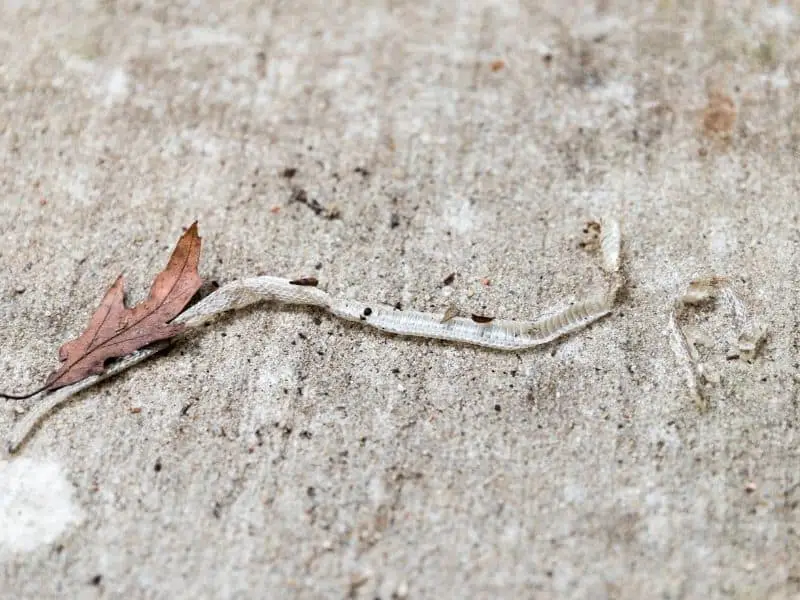
Shed skin
Snakes shed skin corresponding to their growth rate. It can be as frequent as once every month or only a number of times per year. Younger snakes shed more frequently than older ones.
Seeing a shed snake skin inside your garage is a definite sign that a snake has successfully entered, and there is a good possibility that it may still be there and likes to use your garage as its home.
Basking Snakes on the Driveway
If you see snakes basking on your home’s driveway, it means they are taking shelter somewhere near.
Snakes usually bask in the early morning after the day has become warm enough but still not too hot. They do this to raise their temperature after a cold night.
They usually bask within or near their preferred habitat.
Therefore, to see them basking in and around your property, especially on the warm pavement of your driveway, is a sign that it probably takes residence inside your garage or in nearby shelters like piles, debris, and surrounding vegetation.
Rodent infestation
Rodent infestations in your home or garage may coincide with snake presence.
If you have a problem with rodent pests, you can expect snakes to come in as well, especially in areas where there are adjacent snake natural habitats like woods, grasslands, or any other natural areas with native snake populations.
How to Locate the Snake
When there are enough signs to convince you that there is indeed a snake in your garage, you can search for the snake in question.
If the snake is venomous, it is quite dangerous to search and flush them out. You may opt to hire the services of pest and snake removal professionals. You could also set snake traps.
Try to look for the snake and attempt to extract and remove it from your garage if you are sure that it is a harmless species.
Venomous snakes are extremely dangerous, and sometimes, not even species-specific snake antivenin can save snakebite victims. The symptoms and effects are horrifying and the bite can be very fatal.
You can also use snake traps or other means of catching them, such as glue boards or traps. Your traps may use snake food or at least rodent scent. Remember that the attractant in your snake trap may actually invite snakes outside to come into your garage.
If you opt to search your garage, you can begin looking in the hidden, quiet, dark, and secluded corners and areas. You can also search under boxes and other stuff that have spaces underneath them.
Try to also look in areas which can serve as heat sources for the snakes. These include the underparts and back of appliances, the hot tap water heater, and similar heat sources. Some snakes even get their heat from warm vehicle engines!
Snakes are not likely to stay on elevated areas. They will naturally prefer to stay on the ground. Thus, you can focus your search there.
Whenever searching for snakes, make sure you are within safe distance away from their striking range.
Rattlesnakes can have a very long strike reach. It is also important to wear safety gear such as thick, long-sleeved gloves, thick pants that cover your entire leg length, and closed shoes.
The gloves are crucial when lifting boxes and other things under which snakes can be hiding, as they can be startled and strike immediately upon exposure.
How To Get Rid Of Snakes In Your Garage
So you found the snake in your garage and you naturally want to get rid of it. There are many ways you can do this. Let us enumerate them.
Let the snake leave on its own
Given enough opportunity and time, snakes are likely to prefer their natural environment instead of your garage.
Therefore, they may opt to leave on their own in time. If you have removed all the things that make them comfortable, there should be nothing in your garage that will make them want to stay.
Once you locate them behind one of your boxes or appliances, you can create a certain situation wherein they have no other way to leave or move except towards the outside of your garage.
With a little strategy and placement of your garage’s things, you can encourage the snake to slither towards the outdoors on its own.
A misplaced aggressive approach may cause the snake to further hide among your things. Think it through when applying this simple but strategic method. It may not work in all situations and garages.
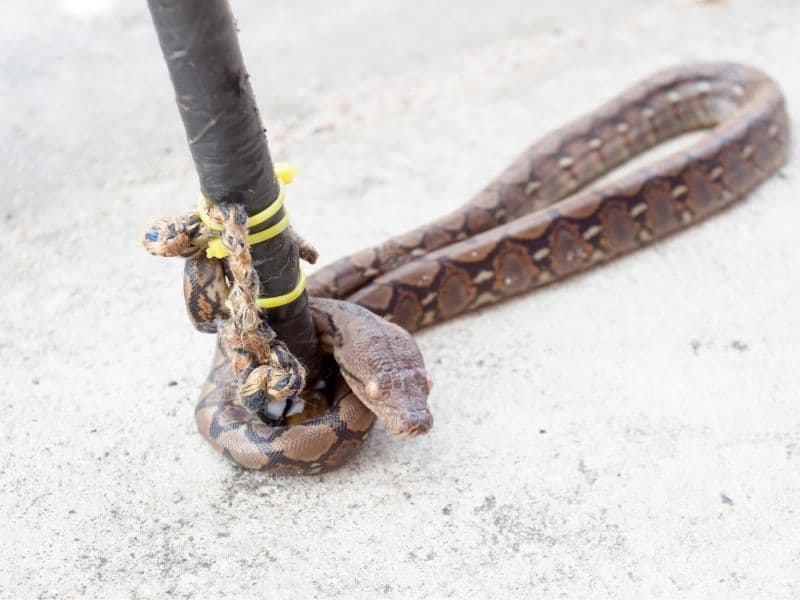
Let the professionals handle it
The safest way for you to get the snake out of the garage is to call a professional animal control and extermination service.
This is the best method especially if the snake is venomous.
Such species of snakes should only be handled by professional and experienced handlers.
Before calling them, try to enclose and trap the snake in a place where you will be sure that it will not come out or escape; otherwise, you may lose it.
Enclosing the snake in a particular area will help the exterminators find and catch the animal more easily once they arrive.
Naturally, do not let your children and pets into the trapped snake’s area while they are awaiting extraction. The professionals will do the rest.
Brush or hose the snake out
You can also shoo away the snake with a broom out of your garage or into a large container where it can be safely trapped.
If it is possible, you can also use a hose to wash it out of your garage or into the container.
You can then release it in the nearby woods with enough distance to your house so that a return will be unlikely.
Make sure you are out of striking range during the entire process. Long broomsticks or poles and a little creativity will ensure you are safe from the snake’s bite.
Trap the snake
You can also use a snake trap if you have not yet seen the snake. There are many methods, some of which may work in your situation.
Pick it up manually
If you are sure that the snake is non-venomous and you are 100% sure you can do it, you can try to pick it up manually for removal from your garage.
Pin the snake’s head with a long stick or similar material.
Pick it up from the back of its head while its head is pinned, and as you lift it from the ground, carry the middle half of its body with your other hand to support it so that it will not get a neck fracture.
You can also pick it up from its tail if it is long enough and if you can maneuver it well enough not to get bitten.
You can either place it in a sealable container or simply proceed to remove it immediately from your premises while holding it.
If you have doubts that you can pull off the method successfully, it is probably not a good idea to do it at all.
Related Questions
If I encounter a snake, should I kill it?
Even though you should always take a snake encounter seriously, in almost every occasion, you do not need to kill it. Simply leave it alone, remove it safely, or let professional snake removal experts take it away. Snakes do not strike when they do not feel threatened.
What animals naturally kill snakes, and are snakes’ natural enemies?
There are many predators of snakes in the animal kingdom.
Many of these are raptors or birds of prey, such as eagles, hawks, falcons, and owls. Many other bird species also kill and eat snakes. Many mammals also prey on snakes. Some snake species also consume snakes, such as kingsnakes.
Sources
- https://www.actiongaragedoor.com/blog/keep-snakes-out-garage/
- https://homeefficiencyguide.com/why-snakes-enter-garages/
- https://ufwildlife.ifas.ufl.edu/preventing_encounters.shtml
- https://www.jcehrlich.com/snakes/how-to-keep-snakes-away/
- https://www.wikihow.com/Get-Rid-of-Snakes
- https://www.nationalgeographic.com/animals/reptiles/group/snakes/
- https://www.trutechinc.com/services/snake-control/garage/
- https://www.homestolove.com.au/7-ways-to-snake-proof-your-house-and-garden-10705
- https://www.abc.net.au/everyday/snake-proofing-your-home/11680644
- https://www.fieldecology.com/blog/snakes-away
- https://cr4.globalspec.com/thread/41880/How-to-Keep-Snakes-Out-of-My-Garage
- http://www.wildlife-removal.com/snake-get-rid.html
- https://extension.usu.edu/news_sections/gardening/12-ways-to-stop-snakes-from-slithering-into-yards
- https://rattlesnakesolutions.com/snakeblog/keep-snakes-away/how-to-keep-snakes-away-from-your-home-the-ultimate-guide/
- https://almnh.museums.ua.edu/resources/ask-the-naturalist/
Photo credit: ©canva.com
Medical Disclaimer: TheHomePestControl is a digital publisher and does not offer personal health or medical advice. The contents of this website are not intended to substitute for professional medical advice, diagnosis, or treatment.
Affiliate Disclaimer: As an Amazon Associate, I earn from qualifying purchases made on our website. If you make a purchase through links from this website, I may earn a commission at no additional cost to you.

![Does Victor Snake-A-Way Work [Expert Opinion]](https://wypestcontrol.com/wp-content/uploads/victor-snake-away-768x576.jpg)

